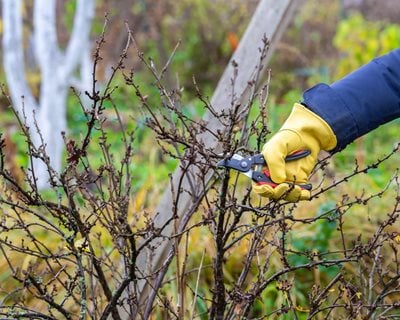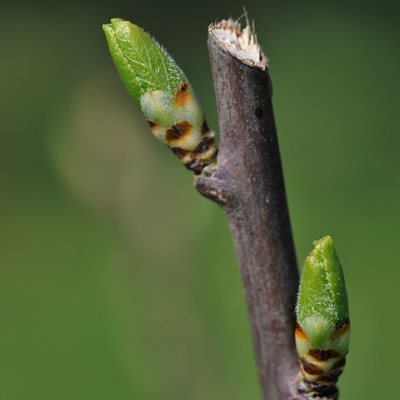How, When & Why to Prune Your Shrubs
Boost your shrubs' health and beauty with proper pruning methods
Photo by: S.O.E. / Shutterstock.
Pruning is a fundamental gardening task that plays a crucial role in maintaining the health and beauty of your garden. Understanding the basics of pruning can seem daunting, but it's essential for promoting healthy growth, improving the appearance of your plants, and ensuring that your garden thrives throughout the seasons.
Pruning isn't just about cutting away branches; it also involves knowing when and how to make cuts that will benefit your shrubs the most. Whether you aim to shape your shrubs into neat, attractive forms or encourage a burst of flowers and fruits, proper pruning techniques can make all the difference.
Learning the basic principles and techniques will give you the confidence to prune your shrubs effectively, keeping your garden looking its best all year round.
WHY PRUNE SHRUBS
There are 5 main reasons to prune your shrubs:
- Encourage healthy growth: Pruning removes dead or diseased branches, allowing the shrub to direct its energy towards healthy growth.
- Shape the plant: Regular pruning helps maintain the desired shape and size of the shrub, enhancing the overall appearance of your garden.
- Increase flowering and fruit production: Proper pruning can stimulate more blooms and fruit production by allowing more light and air to reach the inner branches.
- Prevent overcrowding: Thinning out branches reduces overcrowding, which can lead to poor air circulation and an increased risk of disease.
- Remove hazards: Cutting back overgrown branches prevents them from becoming hazards or interfering with walkways and structures.
WHEN TO PRUNE SHRUBS
Knowing the right time to prune your shrubs is crucial for their health and productivity. Pruning at the appropriate time ensures that you don't remove flower buds or stress the plant, leading to better growth and more beautiful blooms. Here are some general guidelines:
- Spring-flowering shrubs set their buds in summer and fall and bloom on old wood. Prune these immediately after they finish blooming to ensure you don't cut off next year's flowers (the dormant buds). Examples include lilacs and forsythias.
- Summer-flowering shrubs set their buds and bloom on new wood that grows in spring. Prune them in late winter or early spring before new growth begins to encourage robust flowering. Hydrangeas and butterfly bushes fall into this category.
- Evergreen shrubs can be pruned in spring, once new growth starts. This includes boxwoods and holly.
- General guidelines: Avoid pruning in fall, especially in colder climates, as this can stimulate growth that might not harden off before winter, making the plant susceptible to damage from cold weather.
HOW TO PRUNE SHRUBS
- Gather tools: Use sharp hand pruners for small branches, loppers for medium branches, and a pruning saw for thick branches. Clean tools with disinfectant before and after use to prevent the spread of disease.
- Assess the shrub: Check for disease, damage, dead branches, or overcrowding. Determine which pruning methods will best achieve your objectives for the shrub.
- Identify branches to remove: Remove dead or diseased branches first, then any crossing or rubbing branches. Thin out weak or leggy growth to promote stronger growth.
- Make proper cuts: Using sharp, clean tools, make cuts at the correct place and angle for the shrub's health, using thinning, heading, rejuvenation, pinching, or deadheading methods as needed.
- Post-pruning care: Remove all cut branches and leaves from around the shrub to prevent the spread of disease and pests, water the shrub thoroughly, and apply mulch. Monitor the shrub for stress or disease and prune further if needed.
TYPES OF PRUNING CUTS

Photo by: Adrian Muttitt / Alamy Stock Photo
Here are the basic pruning techniques every gardener should know:
- Thinning: Remove entire branches back to a main stem or ground level. Cut just outside the branch collar (enlarged portion where it meets another branch or the trunk; contains specialized cells that help the plant seal the wound). Thinning improves air circulation, reduces overcrowding, and encourages new growth from the base.
- Heading: Selectively remove a portion of a branch just above a bud. Cut at a slight angle above, consider the bud’s direction as this is the direction new branching will go. This encourages these buds to develop into branches, improving plant structure.
- Rejuvenation Pruning: Cut the entire shrub or oldest branches back to 6 to 24 inches above the ground (depending on the plant). Make clean, angled cuts to prevent water pooling on the cut. Also called hard pruning, this revitalizes neglected or overgrown shrubs and promotes fresh, vigorous growth from the base.
- Pinching: Remove growing tips of branches by pinching off the soft, new growth at the tips with fingers or snips. This encourages bushier growth, especially in young shrubs.
- Deadheading: Remove spent flowers by cutting or pinching off faded blooms just above the first set of healthy leaves. This encourages additional blooms by preventing the plant from wasting energy on seed production.
MATCHING PRUNING GOALS TO TECHNIQUES
“To prune plants well is not so much about knowing how and where to cut, but about knowing what you’re trying to achieve," says Steve Bradley, author of The Pruner's Bible. Knowing what you want to accomplish will help determine the technique you want to use.
For encouraging healthy growth:
- Primary technique: Thinning
- Why: Removes dead or diseased branches, improves air circulation
- Secondary technique: Heading
- Why: Stimulates new growth from remaining buds
For shaping the plant:
- Primary technique: Heading
- Why: Directs growth and creates a fuller, more compact shape
- Secondary technique: Pinching
- Why: Encourages bushier growth, especially in young shrubs
For increasing flowering and fruit production:
- Primary technique: Thinning
- Why: Allows more light and air to reach inner branches
- Secondary technique: Deadheading
- Why: Encourages the plant to produce more flowers instead of seeds
For preventing overcrowding:
- Primary technique: Thinning
- Why: Reduces density and improves overall structure
- Secondary technique: Heading
- Why: Can control size and direct growth away from crowded areas
For removing hazards:
- Primary technique: Thinning
- Why: Removes entire problematic branches
- Secondary technique: Heading
- Why: Can redirect growth away from walkways or structures
For rejuvenating old or overgrown shrubs:
- Primary technique: Rejuvenation pruning
- Why: Stimulates vigorous new growth from the base
- Secondary technique: Thinning
- Why: Can be used for gradual rejuvenation over several seasons
Don't be afraid to start small and practice your pruning techniques on less prominent shrubs to build confidence. Pay attention to how your shrubs respond, adjust your methods based on your observations, and remember that mistakes are valuable learning opportunities. By experimenting with different techniques and timing, you'll gradually develop the skills needed to keep your shrubs healthy and beautiful.
RELATED:
Pruning Guides
Pruning Shrubs: A Seasonal Guide
6 Essential Tools for Pruning
10 Common Pruning Mistakes & How to Avoid Them
